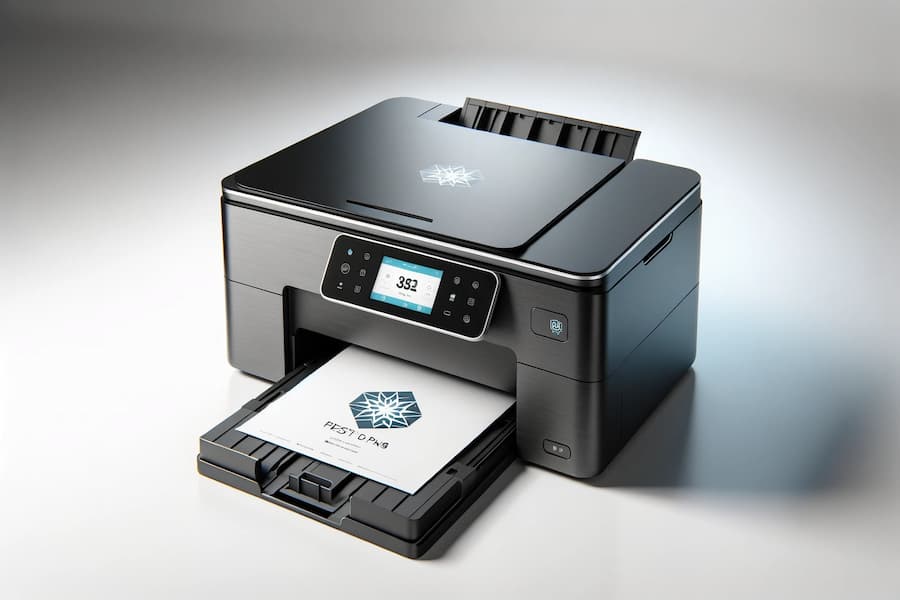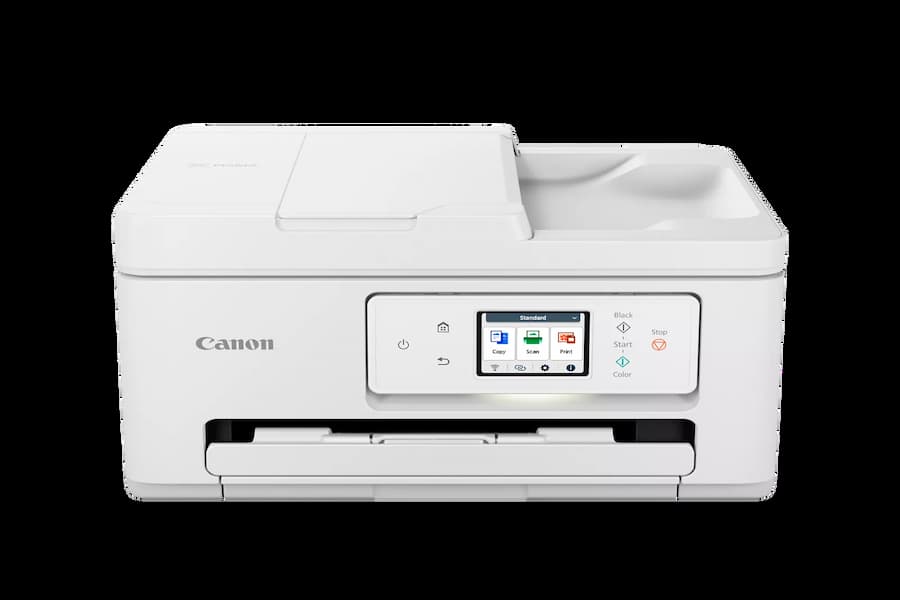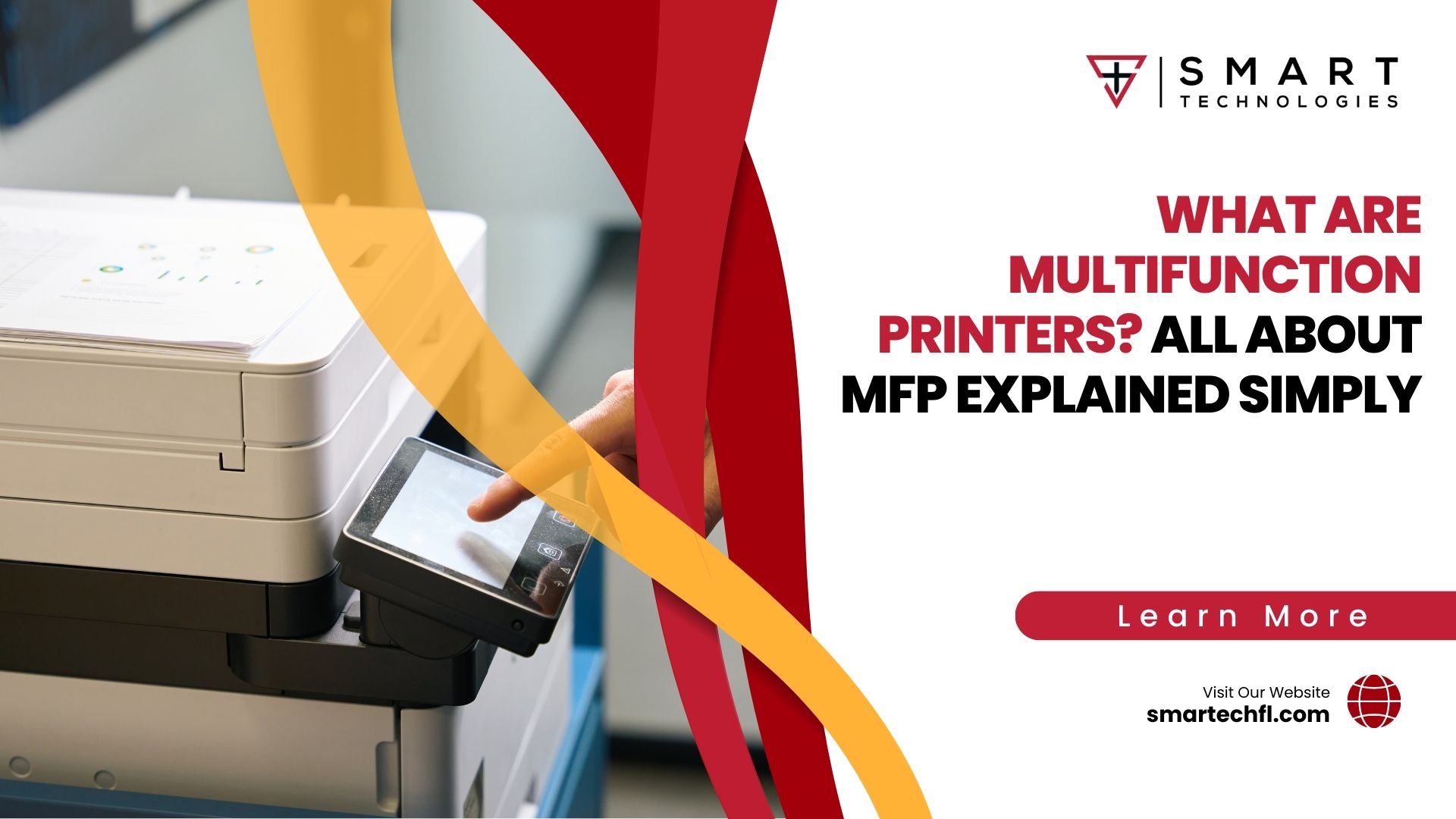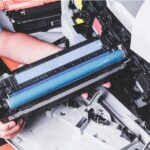What is an inkjet printer – Definition and Working?
What is an inkjet printer?
An inkjet printer operates on a straightforward yet ingenious principle. It precisely propels tiny droplets of ink onto the paper, creating vivid images and crisp text. Unlike a laser printer that uses toner, an inkjet utilizes liquid ink, dispensed through a complex array of nozzles in the print head. This method allows for a remarkable degree of accuracy, down to the microscopic level.
In comparison, laser printers employ a different technique. They use laser toner, a fine powder, to form images and text. The toner is then fused onto the paper using heat. While both types of printers are adept at color printing and can produce high-quality outputs, inkjet technology is often preferred for its ability to render subtle color gradations, making it ideal for photo printing.

History and Evolution of Inkjet Printers
The journey of inkjet printers began in the late 20th century. Initially, they were large, cumbersome machines, reserved for industrial settings. However, as inkjet technology evolved, these printers became more compact and accessible, finding their way into the home office and beyond.
Technological advancements have been pivotal in this evolution. The refinement of the ink cartridge design, for instance, has greatly enhanced image quality. Modern inkjet printers can produce finer, more precise ink droplets, leading to sharper and more vibrant prints. The integration of digital technology has also allowed for more user-friendly interfaces and connectivity options, catering to diverse printing needs.
Types of Inkjet Printers
Inkjet printers come in various models, each tailored to specific needs. The basic division lies between home and professional models. Home inkjet printers are typically more compact, designed for occasional use and smaller print volumes. They are perfect for printing documents, photos, and school projects.
Professional inkjet printers, on the other hand, are built for higher volume and more demanding tasks. They often feature larger ink cartridges, more advanced print heads, and capabilities for wider formats and varied media types. These printers are a staple in design studios, photography labs, and businesses where high-quality color printing is crucial.
Advantages of Inkjet Printers
One of the most notable advantages of inkjet printers is the quality of print. They excel in producing vibrant colors and high-resolution images, making them ideal for photo printing and detailed graphics. The inkjet technology allows for a broader color spectrum, capturing nuances that are often lost with other types of printers.
In addition, inkjet printers offer incredible versatility in media handling. They can print on a variety of surfaces, from glossy photo paper to textured art media. This adaptability makes them a preferred choice for creative professionals and hobbyists alike. Their ability to handle different paper sizes and types also makes them highly versatile for everyday use, whether it’s for printing a simple document or a complex, color-rich brochure.
How Do Inkjet Printers Work
Basic Working Principle of Inkjet Printers
The core function of an inkjet printer is to deposit droplets of ink onto paper with precision and accuracy. This process begins when a digital file is sent to the printer. The printer’s software then translates this file into a map of tiny dots, representing where the ink needs to be placed on the paper.

Inkjet printers use either dye-based or pigment-based inks. Dye-based inks are known for their vibrant colors and are ideal for photo printing. Pigment-based inks, on the other hand, offer longevity and are less prone to fading. The choice of ink depends on the printing needs and the desired outcome.
Components of an Inkjet Printer
The main components of an inkjet printer include the print head, ink cartridges, and the paper feed mechanism. The print head is crucial; it houses numerous microscopic nozzles that spray the ink. Ink cartridges store the ink and are either combined in a single cartridge for all colors or separated into individual cartridges for each color, like cyan, magenta, yellow, and black ink.
The paper feed mechanism smoothly transports the paper through the printer. It ensures that the paper is correctly aligned so that the ink is deposited accurately. Together, these components work in harmony to produce the final printed document or image.
Inkjet Printing Process
The printing process is a symphony of precision and technology. Once the printer receives the data, the print head moves back and forth across the paper. As it moves, it precisely ejects droplets of ink onto the paper. The size and placement of these droplets are controlled by the printer’s software, which dictates the exact pattern needed to recreate the digital image or text.
This process is not just about depositing ink; it’s about doing so with remarkable accuracy. The printer software plays a pivotal role here, ensuring that each droplet of ink lands in the right spot, resulting in clear and crisp printouts.
Maintenance and Troubleshooting
Maintaining an inkjet printer is key to its longevity and performance. Common issues include clogged nozzles and dried ink. Regular cleaning cycles can prevent these problems. It’s also important to use the right type of paper and ink specified for the printer to avoid any printing problems.
When troubleshooting, checking the ink levels and ensuring that the ink cartridges are properly installed is a good start. For more complex issues, referring to the printer’s manual or seeking support from the manufacturer, like HP or Canon, can be helpful. Regular updates of the printer’s software and drivers can also prevent many common issues.
Choosing and Using Inkjet Printers
Selecting the Right Inkjet Printer
When it comes to selecting an inkjet printer, several factors need consideration. First and foremost is print quality. For those prioritizing photo printing, a printer capable of producing high-resolution images with vibrant colors is essential. Speed is another critical factor, especially in a business setting where efficiency is key. However, faster printers may compromise on quality, so it’s a balance.
Cost is a decisive factor too. The initial price of the printer is just the beginning. Consider the cost of ink cartridges and the type of paper used. Some printers, like the HP OfficeJet, offer a good balance between price and performance, making them suitable for home use. Also, think about the printer’s size and connectivity options, ensuring it fits your space and can easily connect to your devices.
Cost-Effectiveness and Efficiency
Inkjet printers can vary significantly in terms of running costs. The price of ink cartridges and their lifespan are crucial. Some models, like Canon PIXMA, are designed to use ink efficiently, reducing the frequency of replacements. To save on ink, consider printers that allow for individual color cartridge replacement, so you only replace what you need.
For economical printing, adjust the printer settings to use less ink. Draft mode is perfect for internal documents where high quality isn’t necessary. Also, consider the type of paper used. Higher quality paper can yield better printouts but at a higher cost. Regular maintenance, like nozzle cleaning, also ensures efficient ink usage and prevents wastage.
Innovations and Future Trends
The world of inkjet printing is constantly evolving. Recent advancements include increased print speeds and enhanced image quality. Printers are becoming more compact and energy-efficient, catering to the growing demand for sustainable solutions.
In the future, we might see further integration of AI and machine learning in printer management, making printers more intuitive and user-friendly. The development of eco-friendly inks and recyclable materials for cartridges is also on the horizon. Additionally, advancements in ink technology could lead to wider color spectrums and even more lifelike prints.
In conclusion, when choosing an inkjet printer, it’s essential to weigh factors like print quality, speed, and cost. Efficient use and regular maintenance can help keep running costs down. With ongoing innovations, inkjet printers continue to offer improved performance and sustainability, making them a versatile choice for both home and professional use.
Difference Between Inkjet and Laser Printers
The primary difference between inkjet and laser printers lies in their printing techniques. Inkjet printers use liquid ink, spraying tiny droplets of ink onto paper to create images.
They excel in photo printing and are better at blending colors. Laser printers, however, use a laser beam to etch images onto a drum, which then gets transferred to paper using laser toner. They are typically faster and more cost-effective for high-volume printing. However, inkjets offer superior color depth and image quality.
How to Improve Print Quality in Inkjet Printers
To enhance print quality in inkjet printers, first ensure you’re using the right type of paper. Different papers absorb ink differently, affecting the final output.
Regular maintenance, like cleaning the print head and aligning it, also improves quality. Using genuine ink cartridges recommended by the manufacturer, such as those for HP OfficeJet or Canon PIXMA, ensures the best results. Finally, adjusting printer settings to match your specific printing task can significantly boost quality.
Best Practices for Ink Cartridge Maintenance
Proper maintenance of ink cartridges is crucial for optimal printer performance. Store unused cartridges in a cool, dry place to prevent drying out. When installing new cartridges, handle them carefully to avoid any damage.
Regularly use your printer; this prevents ink from drying in the nozzles. If you encounter clogged nozzles, most printers have a cleaning function that can resolve this issue. And always use high-quality ink specifically designed for your printer model.
What Type of Paper Should You Use with Inkjet Printers?
For inkjet printers, it’s best to use paper specifically designed for inkjet printing. This type of paper is engineered to absorb ink properly, preventing smudges and ensuring sharp, clear prints. Standard options include matte, glossy, and semi-gloss, each offering different finishes suitable for various needs.
Matte paper is ideal for text-heavy documents, while glossy and semi-gloss are preferred for high-quality photo printing due to their ability to showcase vibrant colors and fine details. Using the correct paper type not only enhances the print quality but also maintains the printer’s optimal performance.
How Do You Know if a Printer is Inkjet?
To determine if a printer is an inkjet, look for key indicators. Firstly, check the printer’s description or model information, usually found on the printer itself or in the user manual, which typically mentions if it’s an inkjet. Inkjet printers use liquid ink cartridges, so opening the printer to see if it contains ink cartridges is another way to tell.
Additionally, inkjet printers are known for their ability to produce high-quality color prints with fine details, making them popular for photo printing. These characteristics can help identify an inkjet printer.
Conclusion
Understanding the nuances of inkjet printing and how it differs from laser printing is key in choosing the right printer. Whether it’s for home use, a small office, or professional photo printing, each type of printer has its strengths.
By following best practices for maintenance and usage, you can ensure your inkjet printer continues to produce high-quality prints and operates efficiently. Remember, the right printer and proper care can make all the difference in meeting your printing needs.
You can contact us by phone, email, or by visiting our offices:
- Phone: (386) 261-8323
- Email: contact@smarttechfl.com
- Address: 771 Fentress Blvd. #10, Daytona Beach, FL 32114












